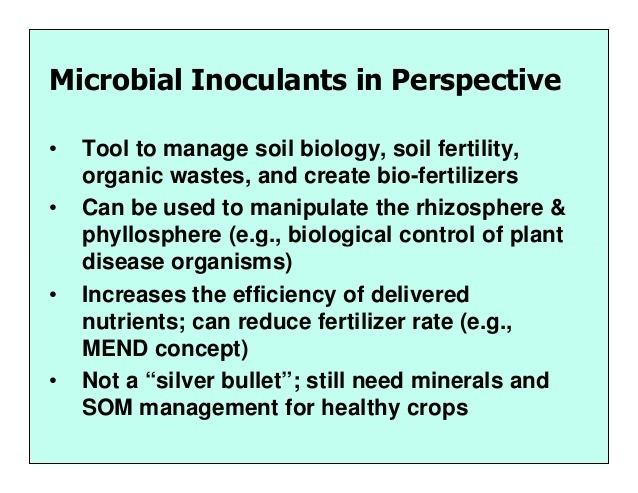 | ||
Microbial inoculants for optimal health in your organic garden
Microbial inoculants also known as soil inoculants are agricultural amendments that use beneficial endophytes (microbes) to promote plant health. Many of the microbes involved form symbiotic relationships with the target crops where both parties benefit (mutualism). While microbial inoculants are applied to improve plant nutrition, they can also be used to promote plant growth by stimulating plant hormone production (Bashan & Holguin, 1997; Sullivan, 2001).
Contents
- Microbial inoculants for optimal health in your organic garden
- Rhizobacterial inoculants
- Nitrogen fixing bacteria
- Phosphate solubilising bacteria
- Fungal inoculants
- Composite inoculants
- References
Research into the benefits of inoculants in agriculture extends beyond their capacity as biofertilizers. Microbial inoculants can induce systemic acquired resistance (SAR) of crop species to several common crop diseases (provides resistance against pathogens). So far SAR has been demonstrated for powdery mildew (Blumeria graminis f. sp. hordei, Heitefuss, 2001), take-all (Gaeumannomyces graminis var. tritici, Khaosaad et al., 2007), leaf spot (Pseudomonas syringae, Ramos Solano et al., 2008) and root rot (Fusarium culmorum, Waller et al. 2005).
Rhizobacterial inoculants
The rhizobacteria commonly applied as inoculants include nitrogen-fixers and phosphate-solubilisers which enhance the availability of the macronutrients nitrogen and phosphorus to the host plant. Such bacteria are commonly referred to as plant growth promoting rhizobacteria (PGPR).
Nitrogen-fixing bacteria
The most commonly applied rhizobacteria are Rhizobium and closely related genera. Rhizobium are nitrogen-fixing bacteria that form symbiotic associations within nodules on the roots of legumes. This increases host nitrogen nutrition and is important to the cultivation of soybeans, chickpeas and many other leguminous crops. For non-leguminous crops, Azospirillum has been demonstrated to be beneficial in some cases for nitrogen fixation and plant nutrition (Bashan & Holguin, 1997).
For cereal crops, diazotrophic rhizobacteria have increased plant growth (Galal et al., 2003), grain yield (Caballero-Mellado et al., 1992), nitrogen and phosphorus uptake (Galal et al., 2003), and nitrogen (Caballero-Mellado et al., 1992), phosphorus (Caballero-Mellado et al., 1992; Belimov et al., 1995) and potassium content (Caballero-Mellado et al., 1992). Rhizobacteria live in root nodes, and are associated with legumes.
Phosphate-solubilising bacteria
To improve phosphorus nutrition, the use of phosphate-solubilising bacteria (PSB) such as Agrobacterium radiobacter has also received attention (Belimov et al., 1995a; 1995b; Singh & Kapoor, 1999). As the name suggests, PSB are free-living bacteria that break down inorganic soil phosphates to simpler forms that enable uptake by plants.
Fungal inoculants
Several different fungal inoculants have been explored for their benefits to plant nutrition. The most commonly investigated fungi for this purpose are the arbuscular mycorrhizae (AM). Other endophytic fungi, such as Piriformis indica can also be beneficial (Waller et al., 2005).
Composite inoculants
The combination of strains of Plant Growth Promoting Rhizobacteria has been shown to benefit rice (Oryza, Nguyen et al. (2002)) and barley (Hordeum, Belimov et al. (1995a)). The main benefit from dual inoculants is increased plant nutrient uptake, from both soil and fertiliser (Bashan et al., 2004; Belimov et al. 1995a). Interestingly, multiple strain inoculants have also been demonstrated to increase total nitrogenase activity compared to single strain inoculants, even when only one strain is diazotrophic (Lippi et al., 1992; Khammas & Kaiser, 1992, Belimov et al. 1995a).
PGPR and arbuscular mycorrhizae in combination can be useful in increasing wheat growth in nutrient poor soil (Singh & Kapoor, 1999) and improving nitrogen-extraction from fertilised soils (Galal et al., 2003). In salinised soils, Rabie (2005) found that inoculating AM-infected Vicia faba plants with Azospirillum brasilense amplified the beneficial effects of AM inoculation.
